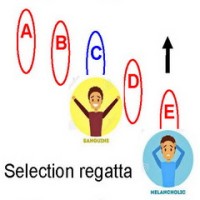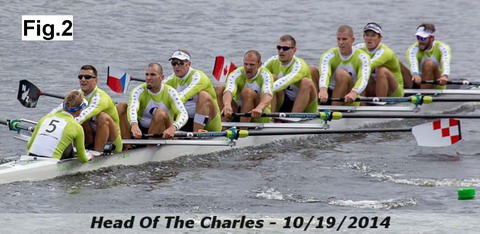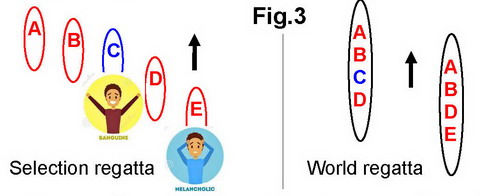More about seat racing for selection

We have previously discussed seat racing (RBN 2013/06) and found that “fair seat racing is not possible in one boat only. It should be done between two or more boats racing one against another, so weather conditions and fatigue would affect all rowers similarly.” Also, an objective seat race must be performed without “preselected” rowers, otherwise, it could just be a conscious or subconscious vote for crewmates. The conclusion was: “Objective selection for big boats must be done based on performance in standard races over 2km in small boats (singles and pairs).”
A very common counterargument to this is that the “four fastest pairs do not always make the fastest eight”, or a similar statement about singles in a quad. Quite often, this statement is confirmed with the results of seat-racing, even in its objective format, so it would be good to discuss why it happens. Three types of factors could be identified here: biomechanical, physiological and psychological.
The nature of the biomechanical factors of a crew’s efficiency are quite clear: good synchronisation in a crew and the rowers’ ability to produce the highest rowing power, which again is affected by synchronisation. As the rowers’ masses are connected through the stretcher and boat hull, they must move synchronously, especially during the rapid change of direction at the catch. This topic has already been discussed many times (RBN 2011/02, 2012/04, 2015/03, 2017/07) and we will not repeat the details here and will just restate that poor synchronisation in a crew cancels the “trampoline effect”, increases inertial energy losses and decreases total power production, thus lowering rowing speed. Another point will be focused on here: how can we expect good synchronisation in randomly formed crews during seat-racing? It is obvious fact that successful big boats are made from many miles of rowing together, sometimes it takes years to obtain a common rowing rhythm and perfect crew synchronicity. Then why do we expect rowers to achieve this in merely a few minutes?

Imagine this very simple example (Fig.1): a quad is to be selected from 5 scullers. Four of them (A,B,D,E) are from the same area, or even from the same club/coach/crew, so they have very similar rowing styles and experience rowing together. Sculler E in this group is big and strong on the erg, but was not fast in the single at the selection regatta, placing for example somewhere in the B-final. Sculler C in this group is not very big, is from a small club in a remote area and has a different rowing style, but performed well at the selection regatta, e.g., 3rd place in the single. What happens if we “seat-race” this group? Of course, the style of sculler E would fit much better to the main group A-B-D and the quad would be faster with them than with sculler C, who would be rejected in this case. Does this mean that the technical efficiency of sculler C is not good enough for selection? Of course it doesn’t, and evidence for that is the good results of C in the single, so they must have quite an efficient rowing style and a good power/weight ratio. What would be the best selection decision in this case? Sculler C could be placed at stroke and their crewmates A-B-D should be coached to follow the effective rowing style of C. After some training together, this quad could be much faster than the successfully seat-raced crew with sculler E.
Additionally, although rowers can adapt their technique and rhythm in random crews, some are very flexible and can do it in minutes, whereas others with more rigid motor control may require hours of rowing in a formed crew. This does not mean that they are bad rowers: contrarily, they may be more consistent in maintaining good technique once they have learned it and could maintain it in various situations.
Concluding on biomechanical factors, random seat-racing could be used only for the selection of rowers with similar styles and experience of rowing together, say, for the first crew in a club or school.
From a physiology point of view, there is no reason why good single scullers cannot form a good big boat, because they must have a high power/weight ratio. There were cases, when collections of the World best scullers in “Great Eight” (Fig.2) had beaten champion eights at head regattas.

The only possible doubt is that movements are faster in big boats, so rowers with slower-twitch muscle fibres may be good in small boats, but less efficient in big boats. However, with the speed difference of only about 15% and ability to correct using oar static and dynamic gearing (RBN 2020/07), it is very unlikely that small boat performers will not be able to adapt to faster boats.
From a psychology point, rowers’ characters compatibility in a crew must be managed with good coaching. Also, there are examples of very successful crews, where the rowers were not exactly best friends, and had conflicts. Some even believe that an internal conflict is necessary to push a team to its best performance, but we will not discuss it here as it is outside our area of expertise. What is important here is the different level of stress at an official regatta and at seat-racing.

Going back to our previous example, imagine that sculler C has a strong fighter character, and E has a weak psychic (Fig.3). This could be an additional factor for why C performed better at the selection regatta at high stress, but seat-racing may have been less stimulating than a regatta and led to worse performance. Contrarily, E failed at the regatta, but did better at trials in a calmer training-like situation. What happens if sculler E is selected and the crew goes to a World regatta? It is quite likely that sculler E would panic at high stress and the quad would fail, so the selection of the athlete C would be much better choice for psychology reason as well. Concluding, athletes perform differently at regattas high stress and at seat-racing with lower stress, so the selection regatta must be prioritised.

Very often coaches try to use data from biomechanical testing for selection purposes, and even ask me which rower would be better for the main crew. I always feel uncomfortable in this situation as I see my main role is to help every rower to improve their technique, and I usually remind coaches about the importance of the other factors mentioned above. Quite often, biomechanical testing is combined with seat-racing to make it more informative and objective. However, the psychological stress-factor is very different between testing and the regatta. I think that using of biomechanical data for selection purposes should be very limited, e.g. for selection between rowers with similar results in small boats.
The three types of factors above may be considered for selection of the best combination of given athletes for a specific event or season. However, there is another more important factor: motivation of the many other athletes in current and even future generations, which affects the development of the whole sport of rowing. If objective selection criteria are set, the targets are clear for everyone: train hard, fight fearlessly at the selection regatta, and you’ll make the team. This system gives way to strong characters and creates great athletes, real “stars”, which push forward the development of the whole sport. Alternatively, “subjective” selection at seat-racing would benefit more sociable rowers with “soft skills”, some of them would try to find “loopholes” to success through personal “favouritism” with coaches and crewmates, but potential “stars” may be kicked out. This “subjective” system could be comfortable for some coaches and managers and may create some average performance level with a few medals, but it would never make the bright stars that attract youth to this sport and increase its popularity and standing level.
My last point is more philosophical, about the nature of sport as a social concept. Competition in many areas of our life (arts, music, fashion, media, politics, etc.) is more or less subjective, it is a “matter of taste” of the audience. Even in business and economy, we know very well, less competitive in value-for-money products could be successful with effective marketing and aggressive advertising; good workers may fail to get a job, which is given to their more sociable competitors with “soft skills”. I think sport remains the only positive objective competition these days and this is its real value for us. Sport is a sort of model of our life with a very quick response: work-effort-success. In modern society, sport is a replacement of war with its negative objective competition, with destruction of an enemy. This makes sport invaluable for the development of strong character in young people, their hardworking skills, courage, self-sufficiency and real team-playing, but it must be objective to serve these purposes. Even artistic sport must follow this rule: a few years ago, figure skating had problems with objective judgement and faced exclusion from Olympics, but they changed their rules and now they even have World records! Therefore, any sport must be objective, if it is subjective, it is not a sport, but something else…
©2021 Dr. Valery Kleshnev www.biorow.com



